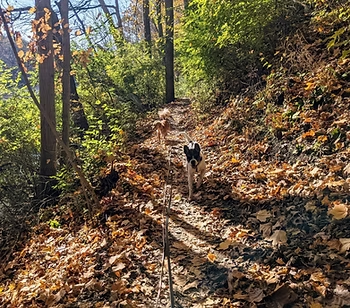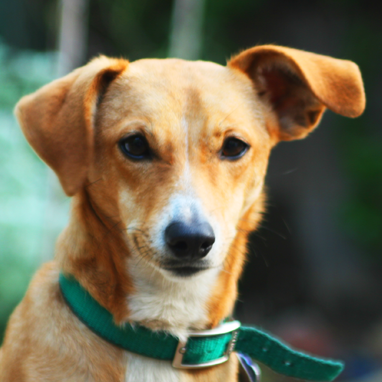Lets talk dogs and kiddos!
As a certified Family Paws Parent Educator and multi-certified dog behavior consultant, I personally felt pretty prepared for the process of helping my two senior dogs adjust to my toddler.
Unfortunately, there are not enough good resources out there for pet parents about this topic. As a first time mom, I could absolutely see how overwhelming and confusing it could be to figure out how to help my dogs and my toddler be safe and happy in my home together. So I created this post with some KEY things I wish all toddler parents with dogs knew.
1. Know What Makes Your Dog Uncomfortable (and How to Read Their Body Language)
This one is HUGE. Every dog is different. Every child is different. What feels safe and fun for one dog and child pair might be very unsafe for another. The key is understanding your individual dog. You need to know what types of things make them nervous, excited, or stressed, and what type of body language they show!
Start by thinking about your dog’s past behavior.
- What kinds of situations have made them nervous or stressed before?
- Think about sights, sounds, situations, behaviors of others, etc
- What body language do they show when they’re uncomfortable?
Keep in mind that many times, stress signs are subtle, not super obvious. Dogs typically show several signs of being uncomfortable before more obvious things like growling.
Here are a few common toddler behaviors that can make dogs uneasy:
- Crawling or walking toward the dog while they’re resting
- Reaching or grabbing at fur
- Trying to climb or hug the dog
- Approaching when the dog has a toy, food, or bone
- Loud, unpredictable movement or yelling
Knowing your dog’s preferences and signals helps you set everyone up for success because it helps you learn how to avoid putting your dog and toddler in situations that are unsafe.
2. Find Opportunities for Safe and Positive Interactions
Once you know what makes your dog uncomfortable, you can focus on situations where your dog feels comfortable and happy. This is where you can work on opportunities to safely include your dog and toddler together in certain daily routines and activities! Safe, positive interactions help both your dog and child feel more relaxed around each other.
The truth is that these types of interactions are going to look different for every dog and child pair.
For some families, this might look like parallel play, where your toddler playing on one side of an adult while your dog relaxes on the other. For others, it might look like involving your dog in a daily routine such as going for walks with your toddler in a stroller or carrier. It all depends on the comfort level of your dog, your child, and you!
Remember that the goal here is not for your dog and toddler to be all over each other or to be best friends. The goal is to find safe and comfortable ways to include both your dog and toddler in your daily activities!
Here are just a few examples of setups that work for some dogs and toddler pairs
- Parallel play with a parent right in between (image of blog post is an example of this)
- sometimes we add things like gates or playpens for parallel play
- High chair time!
- Some dogs who might resource guard or be too pushy about falling food would not be safe for this interaction
- Walks
- With the child in the stroller or carrier
- Training time!
- Some toddlers might enjoy being held or in a toddler tower while you train your dog nearby. My son loves watching my dogs do their tricks!
3. Remember That Separation Is Healthy and Actually Can Help Relationships Grow
Many families feel guilty about keeping dogs and toddlers separated, but in reality, separation is a sign of good parenting (to both our dog and humans!)
Use baby gates, crates, playpens, or safe space rooms to create downtime for both your dog and your toddler. This gives your dog a chance to rest and your child a chance to play freely.
The reality is that there are usually always situations where it is best to have dogs and toddlers kept separated during your daily life. Any time an adult is not actively supervising and engaged in an interaction between them, there should be some levels of safety between the two.
You might be wondering: But if my dog and my toddler are doing well together, why should I have to separate them at all?
Because toddlers are unpredictable, don’t understand dog body language, and cannot control their behavior. And they are likely going to want to step on, yank on, and be all over your dog. And even dogs who tolerate this type of behavior do not deserve to have to. Because you never know if your dog might be having a bad day and react to this type of interaction. To put it simply, it just isn’t safe.
Over time, these breaks and separation efforts should actually help the bond grow stronger, because both you are preventing negative and stressful interactions from occurring between your dog and toddler.
Here’s a personal example: my dog Hewie gets uncomfortable in tight spaces around my very mobile and active toddler. So in the house, they are mostly kept separated if my son is “on the loose”. And now when we go outside and we are walking in our large yard, Hewie is very happy to share space with my son. Because being outside helps him feel more comfortable and less overwhelmed by all that toddler energy. That fact that I use separation inside is actually helping them to do better around each other!
If you have questions about your dog around babies or toddlers, please feel free to reach out to me!
I offer:
- Ask A Behavior Consultant (quick 30 minute “pick my brain” consult) or full training packages (both in-person or online) if you want a customized plan for success between your dog and child!




